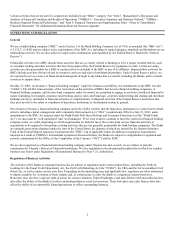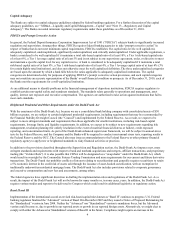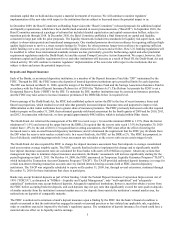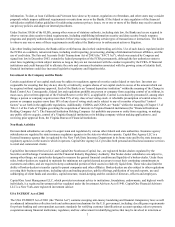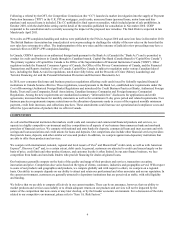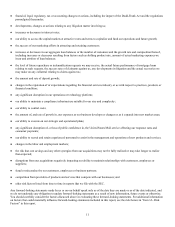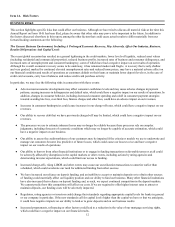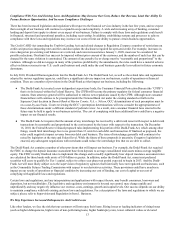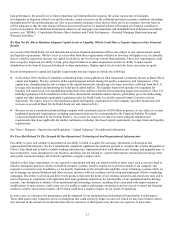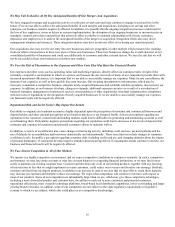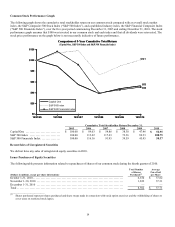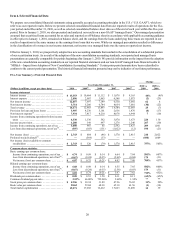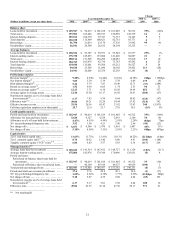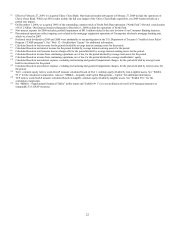Capital One 2010 Annual Report Download - page 32
Download and view the complete annual report
Please find page 32 of the 2010 Capital One annual report below. You can navigate through the pages in the report by either clicking on the pages listed below, or by using the keyword search tool below to find specific information within the annual report.
12
Item 1A. Risk Factors
BUSINESS RISKS
This section highlights specific risks that could affect our business. Although we have tried to discuss all material risks at the time this
Annual Report on Form 10-K has been filed, please be aware that other risks may prove to be important in the future. In addition to
the factors discussed elsewhere in this report, among the other factors that could cause actual results to differ materially from our
forward looking statements are the following:
The Current Business Environment, Including A Prolonged Economic Recovery, May Adversely Affect Our Industry, Business,
Results Of Operations And Capital Levels
The recent global recession has resulted in a general tightening in the credit markets, lower levels of liquidity, reduced asset values
(including residential and commercial properties), reduced business profits, increased rates of business and consumer delinquency, and
increased rates of unemployment and consumer bankruptcy, some of which have had a negative impact on our results of operation.
Although the overall economic recovery seems to be underway, it has remained modest and fragile. A recovery that is only shallow
and very gradual, marked by continued elevated unemployment rates and reduced home prices, may have a material adverse effect on
our financial condition and results of operations as customers default on their loans or maintain lower deposit levels or, in the case of
credit card accounts, carry lower balances and reduce credit card purchase activity.
In particular, we may face the following risks in connection with these events:
● Adverse macroeconomic developments may affect consumer confidence levels and may cause adverse changes in payment
patterns, causing increases in delinquencies and default rates, which could have a negative impact on our results of operations. In
addition, changes in consumer behavior, including decreased consumer spending and a shift in consumer payment strategies
towards avoiding late fees, over-limit fees, finance charges and other fees, could have an adverse impact on our revenues.
● Increases in consumer bankruptcies could cause increases in our charge-off rates, which could have a negative impact on our
revenues.
● Our ability to recover debt that we have previously charged-off may be limited, which could have a negative impact on our
revenues.
● The processes we use to estimate inherent losses may no longer be reliable because these processes rely on complex
judgments, including forecasts of economic conditions which may no longer be capable of accurate estimation, which could
have a negative impact on our business.
● Our ability to assess the creditworthiness of our customers may be impaired if the criteria or models we use to underwrite and
manage our customers become less predictive of future losses, which could cause our losses to rise and have a negative
impact on our results of operations.
● Our ability to borrow from other financial institutions or to engage in funding transactions on favorable terms or at all could
be adversely affected by disruptions in the capital markets or other events, including actions by rating agencies and
deteriorating investor expectations, which could limit our access to funding.
● Increased charge-offs, rising LIBOR and other events may cause our securitization transactions to amortize earlier than
scheduled, which could accelerate our need for additional funding from other sources.
● We have increased our reliance on deposit funding, and an inability to accept or maintain deposits or to obtain other sources
of funding could materially affect our liquidity position and our ability to fund our business. Many other financial institutions
have also increased their reliance on deposit funding and, as such, we expect continued competition in the deposit markets.
We cannot predict how this competition will affect our costs. If we are required to offer higher interest rates to attract or
maintain deposits, our funding costs will be adversely impacted.
● Regulators, rating agencies or investors could change their standards regarding appropriate capital levels for banks in general
or our company in particular. If the new standards call for capital levels higher than the capital we have or that we anticipate,
it could have negative impacts on our ability to lend or to grow deposits and on our business results.
● Increased prepayments, refinancing or other factors could lead to a reduction in the value of our mortgage servicing rights,
which could have a negative impact on our financial results.


